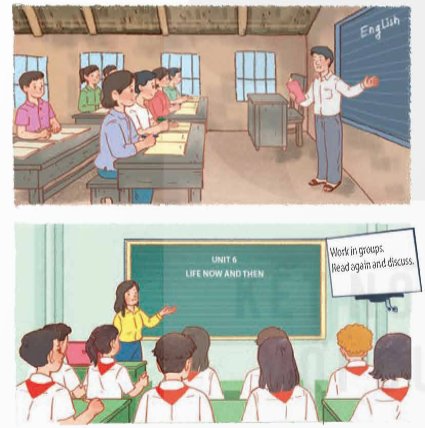Two people of different generations are talking about their learning styles. Read the passages and choose the correct answer A, B, C, or D.

Mr Nam, grandfather, a 70-year-old farmer
I was one of the few children in my village who was still at school at the age of 15. Every day, I got up early and walked to school. Learning then depended mostly on our teachers and textbooks. We had no library or lab. The nearest bookshop was six kilometres away. I learned simply by taking notes during class, memorising them, and doing the homework. Life then was simple. We rarely travelled outside our village, so we didn't know much about the world around us.
Mai, granddaughter, a 15-year-old student
Learning today is very different from my grandfather's time. It is easier and more convenient. Besides learning from teachers and textbooks, we use the Internet. It provides us with various online sources such as documents, clips, and programmes. Google helps us find the answers to almost any questions we have. The Internet also allows us to pursue our own interests. Learning has become more independent. Although most children in my village have fewer private learning facilities than the students in the city, we are still luckier than my grandfather's generation. We have TVs to watch at home and a library and computers at school.
1. In Mr Nam's time, __________.
A. teachers played an important role
B. there were no bookshops
C. students did experiments in labs
D. all children stayed on at school until they were 15
2. Few people travelled outside their village, so __________.
A. life in the village was simple
B. his school didn't have any learning facilities
C. the villagers didn't know much about the world around
D. none of the villagers knew about city life
3. Learning now __________.
A. does not require textbooks
B. uses some online programmes
C. depends only on the Internet
D. does not require students to take notes
4. The word "It" refers to __________.
A. leaming today
B. my grandfather's time
C. learning facilities
D. the Internet
5. The word "we" refers to __________.
A. learning facilities
B. students at my grandfather's generation
C. students in the city
D. children in the village
1. A | 2. C | 3. B | 4. A | 5. D |
In Mr Nam's time, teachers played an important role.
(Vào thời ông Nam, thầy trò đóng vai trò quan trọng.)
A. teachers played an important role
(giáo viên đóng một vai trò quan trọng)
B. there were no bookshops
(không có hiệu sách)
C. students did experiments in labs
(học sinh đã làm thí nghiệm trong phòng thí nghiệm)
D. all children stayed on at school until they were 15
(tất cả trẻ em ở lại trường cho đến khi chúng 15 tuổi)
Thông tin: Learning then depended mostly on our teachers and textbooks.
(Việc học lúc đó phụ thuộc chủ yếu vào thầy cô và sách giáo khoa.)
2. C
Few people travelled outside their village, so the villagers didn't know much about the world around.
(Rất ít người đi du lịch ra ngoài làng của họ nên dân làng không biết nhiều về thế giới xung quanh.)
A. life in the village was simple
(cuộc sống ở làng rất đơn giản)
B. his school didn't have any learning facilities
(trường học của anh ấy không có bất kỳ cơ sở học tập nào)
C. the villagers didn't know much about the world around
(dân làng không biết nhiều về thế giới xung quanh)
D. none of the villagers knew about city life
(không ai trong làng biết về cuộc sống thành phố)
Thông tin: We rarely travelled outside our village, so we didn't know much about the world around us.
(Chúng tôi hiếm khi đi ra ngoài làng nên không biết nhiều về thế giới xung quanh.)
3. B
Learning now uses some online programmes.
(Việc học hiện nay sử dụng một số chương trình trực tuyến.)
A. does not require textbooks
(không yêu cầu sách giáo khoa)
B. uses some online programmes
(sử dụng một số chương trình trực tuyến)
C. depends only on the Internet
(chỉ phụ thuộc vào Internet)
D. does not require students to take notes
(không yêu cầu học sinh ghi chép)
Thông tin: Besides learning from teachers and textbooks, we use the Internet. It provides us with various online sources such as documents, clips, and programmes.
(Bên cạnh việc học từ giáo viên và sách giáo khoa, chúng ta còn sử dụng Internet. Nó cung cấp cho chúng tôi nhiều nguồn trực tuyến khác nhau như tài liệu, clip và chương trình.)
4. A
The word “It” refers to learning today.
(Từ “It” ám chỉ việc học ngày nay. )
A. learning today
(học tập ngày nay)
B. my grandfather's time
(thời ông tôi)
C. learning facilities
(cơ sở vật chất học tập)
D. the Internet
(mạng Internet)
Thông tin: Learning today is very different from my grandfather's time. It is easier and more convenient.
(Việc học ngày nay rất khác so với thời ông nội tôi. Nó dễ dàng và thuận tiện hơn.)
5. D
The word “we” refers to children in the village.
(Từ “we” dùng để chỉ trẻ em trong làng )
A. learning facilities
(cơ sở vật chất học tập)
B. students at my grandfather's generation
(học sinh ở thế hệ ông nội tôi)
C. students in the city
(học sinh ở thành phố)
D. children in the village
(trẻ em trong làng)
Thông tin: Although most children in my village have fewer private learning facilities than the students in the city, we are still luckier than my grandfather's generation.
(Dù hầu hết trẻ em ở làng tôi có ít cơ sở học tập riêng hơn học sinh thành phố nhưng chúng tôi vẫn may mắn hơn thế hệ ông nội tôi.)


